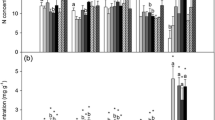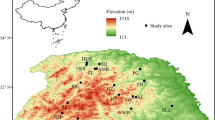Abstract
Ombrotrophic bog peatlands are nutrient-deficient systems and important carbon (C) sinks yet the stoichiometry of nitrogen (N), phosphorus (P) and potassium (K), essential for plant growth and decomposition, has rarely been studied. We investigated the seasonal variation in C, N, P, and K concentrations and their stoichiometric ratios in photosynthetically active tissues of 14 species belonging to five plant functional types (PFTs) (mosses, deciduous trees/shrubs, evergreen shrubs, graminoids, and forb) at Mer Bleue bog, an ombrotrophic peatland in eastern Ontario, Canada. Although we observed variations in stoichiometry among PFTs at peak growing season, there was convergence of C:N:P:K to an average mass ratio of 445:14:1:9, indicating N and P co-limitation. Nitrogen, P, and K concentrations and stoichiometric ratios showed little seasonal variation in mosses, evergreens, and graminoids, but in forb and deciduous species were the largest in spring and decreased throughout the growing season. Variations in nutrient concentrations and stoichiometric ratios among PFTs were greater than seasonal variation within PFTs. Plants exhibit N and P co-limitation and adapt to extremely low nutrient availability by maintaining small nutrient concentrations in photosynthetically active tissues, especially for evergreen shrubs and Sphagnum mosses. Despite strong seasonal variations in nutrient availabilities, few species show strong seasonal variation in nutrient concentrations, suggesting a strong stoichiometric homeostasis at Mer Bleue bog.




Similar content being viewed by others
References
Aerts R. 1996. Nutrient resorption from senescing leaves of perennials: are there general patterns? J Ecol 84:597–608.
Aerts R, Berendse F. 1988. The effect of increased nutrient availability on vegetation dynamics in wet heathlands. Vegetatio 76:63–9.
Aerts R, Chapin FS. 2000. The mineral nutrition of wild plants revisited: a re-evaluation of processes and patterns. Adv Ecol Res 30:1–67.
Aerts R, van Bodegom PM, Cornelissen JHC. 2012. Litter stoichiometric traits of plant species of high-latitude ecosystems show high responsiveness to global change without causing strong variation in litter decomposition. New Phytol 196:181–8.
Aerts R, Wallén B, Malmer N. 1992. Growth-limiting nutrients in Sphagnum-dominated bogs subject to low and high atmospheric nitrogen supply. J Ecol 80:131–40.
Aldous AR. 2002. Nitrogen translocation in Sphagnum mosses: effects of atmospheric nitrogen deposition. New Phytol 156:241–53.
Arndal MF, Illeris L, Michelsen A, Albert K, Tamstorf M, Hansen BU. 2009. Seasonal variation in gross ecosystem production plant biomass and carbon and nitrogen pools in five high arctic vegetation types. Arct Antarct Alp Res 41:164–73.
Arnon DI. 1949. Copper enzymes in isolated chloroplasts polyphenoloxidase in Beta vulgaris. Plant Physiol 24:1–15.
Basiliko N. 2004. Nutrient substrate and microbial-ecological links to decomposition and greenhouse production in northern peatlands. Montreal: McGill University. PhD thesis.
Bedford BL, Walbridge MR, Aldous A. 1999. Patterns in nutrient availability and plant diversity of temperate North American wetlands. Ecology 80:2151–69.
Berendse F, Van Breemen N, Rydin H, Buttler A, Heijmans M, Hoosbeek MR, Lee JA, Mitchell E, Saarinen T, Vasander H, Wallén B. 2001. Raised atmospheric CO2 levels and increased N deposition cause shifts in plant species composition and production in Sphagnum bogs. Glob Change Biol 7:591–8.
Bobbink R, Hornung M, Roelofs JGM. 1998. The effects of air-borne nitrogen pollutants on species diversity in natural and semi-natural European vegetation. J Ecol 86:717–38.
Bragazza L, Tahvanainen T, Kutnar L, Rydin H, Limpens J, Hájek M, Grosvernier P, Hájek T, Hajkova P, Hansen I, Iacumin P, Gerdol R. 2004. Nutritional constraints in ombrotrophic Sphagnum plants under increasing atmospheric nitrogen deposition in Europe. New Phytol 163:609–16.
Bubier JL, Moore TR, Bledzki LA. 2007. Effects of nutrient addition on vegetation and carbon cycling in an ombrotrophic bog. Glob Change Biol 13:1168–86.
Chapin FS, Johnson DA, Mckendrick JD. 1980. Seasonal movement of nutrients in plants of differing growth form in an Alaskan tundra ecosystem: implications for herbivory. J Ecol 68:189–209.
Cleveland CC, Liptzin D. 2007. C:N:P stoichiometry in soil: is there a “Redfield ratio” for the microbial biomass? Biogeochemistry 85:235–52.
Canadian Climate Normals. 1981–2010. National climate data and information archive. http://climateweatherofficeecgcca/climate_normals. Accessed 02 Sept 2013.
Elser JJ, Fagan WF, Denno RF, Dobberfuhl DR, Folarin A, Huberty A, Interlandi S, Kilham SS, McCauley E, Schulz KL, Siemann EH, Sterner RW. 2000. Nutritional constraints in terrestrial and freshwater food webs. Nature 408:578–80.
Gunnarsson U, Rydin H. 2000. Nitrogen fertilization reduces Sphagnum production in bog communities. New Phytol 147:527–37.
Güsewell S. 2004. N:P ratios in terrestrial plants: variation and functional significance. New Phytol 164:243–66.
Güsewell S, Koerselman M. 2002. Variation in nitrogen and phosphorus concentrations of wetland plants. Perspect Plant Ecol 5:37–61.
Hessen DO, Agren GI, Anderson TR, Elser JJ, de Ruiter PC. 2004. Carbon sequestration in ecosystems: the role of stoichiometry. Ecology 85:1179–92.
Hiscox JD, Israelstam GF. 1979. Method for the extraction of chlorophyll from leaf tissue without maceration. Can J Bot 57:1332–4.
Hoosbeek MR, Van Breemen N, Vasander H, Buttler A, Berendse F. 2002. Potassium limits potential growth of bog vegetation under elevated atmospheric CO2 and N deposition. Glob Change Biol 8:1130–8.
Jiroušek M, Hájek M, Bragazza L. 2011. Nutrient stoichiometry in Sphagnum along a nitrogen deposition gradient in highly polluted region of Central-East Europe. Environ Pollut 159:585–90.
Kercher SM, Zedler JB. 2004. Flood tolerance in wetland angiosperms: a comparison of invasive and noninvasive species. Aquat Bot 80:89–102.
Kerkhoff AJ, Enquist BJ. 2006. Ecosystem allometry: the scaling of nutrient stocks and primary productivity across plant communities. Ecol Lett 9:419–27.
Killingbeck KT. 1986. The terminological jungle revisited: making a case for use of the term resorption. Oikos 46:263–4.
Koerselman W, Meuleman AFM. 1996. The vegetation N:P ratio: a new tool to detect the nature of nutrient limitation. J Appl Ecol 33:1441–50.
Končalová H. 1990. Anatomical adaptations to waterlogging in roots of wetland graminoids: limitations and drawbacks. Aquat Bot 38:127–34.
Konings H, Verhoeven JTA, Groot R. 1992. Growth characteristics and seasonal allocation patterns of biomass and nutrients in Carex species growing in floating fens. Plant Soil 147:183–96.
Larmola T, Bubier JL, Kobyljanec C, Basiliko N, Juutinen S, Humphreys E, Preston M, Moore TR. 2013. Vegetation feedbacks of nutrient addition lead to a weaker carbon sink in an ombrotrophic bog. Glob Change Biol 19:3729–39.
LeBauer DS, Treseder KK. 2008. Nitrogen limitation of net primary productivity in terrestrial ecosystems is globally distributed. Ecology 89:371–9.
Loladze I, Elser JJ. 2011. The origins of the Redfield nitrogen-to-phosphorus ratio are in a homoeostatic protein-to-rRNA ratio. Ecol Lett 14:244–50.
Malmer N, Horton DG, Vitt DH. 1992. Element concentrations in mosses and surface waters of western Canadian mires relative to precipitation chemistry and hydrology. Ecography 15:114–28.
Marschner H. 1995. Mineral nutrition of higher plants. San Diego, CA: Academic Press. p 889.
McGroddy ME, Daufresne T, Hedin LO. 2004. Scaling of C:N:P stoichiometry in forests worldwide: implications of terrestrial Redfield-type ratios. Ecology 85:2390–401.
Moore T, Bubier J, Frolking S, Lafleur P, Roulet N. 2002. Plant biomass, production and CO2 exchange in an ombrotrophic bog. J Ecol 90:25–36.
Moore TR, Trofymow JA, Prescott CE, Titus BD. 2011. Nature and nurture in the dynamics of C, N and P during litter decomposition in Canadian forests. Plant Soil 339:163–75.
Moore TR, Trofymow JA, Siltanen M, Korzk LM. 2008. Litter decomposition and nitrogen and phosphorus dynamics in peatland and uplands over 12 years in central Canada. Oecologia 157:317–25.
Murphy J, Riley JP. 1962. A modified single solution method for determination of phosphate in natural waters. Anal Chim Acta 26:31–6.
Olde Venterink H, Wassen MJ, Verkroost AWM, de Ruiter PC. 2003. Species richness-productivity patterns differ between N-, P- and K-limited wetlands. Ecology 84:2191–9.
Pakarinen P, Gorham E. 1983. Mineral element composition of Sphagnum fuscum peats collected from Minnesota, Manitoba and Ontario. In: Spigarelli S, Ed. Proceedings of the international peat symposium. Bemidji: Bemidji State University. p. 471–9.
Parkinson JA, Allen SE. 1975. Wet oxidation procedure suitable for determination of nitrogen and mineral nutrients in biological material. Commun Soil Sci Plant Anal 6:1–11.
Richardson CJ, Marshall PE. 1986. Processes controlling movement storage and export of phosphorus in a fen peatland. Ecol Monogr 56:279–302.
Rydin H, Jeglum JK. 2006. The biology of peatlands. New York: Oxford University Press. p 343.
Sterner RW, Elser J. 2002. Ecological stoichiometry: the biology of elements from molecules to the biosphere. Prinston, NJ: Princeton University Press. p 439.
Tarnocai C. 2006. The effect of climate change on carbon in Canadian peatlands. Glob Planet Change 53:222–32.
Thormann MN, Bayley SE. 1997. Aboveground plant production and nutrient content of the vegetation in six peatlands in Alberta, Canada. Plant Ecol 131:1–16.
Turunen J, Roulet NT, Moore TR, Richard PJH. 2004. Nitrogen deposition and increased carbon accumulation in ombrotrophic peatlands in eastern Canada. Glob Biogeochem Cycles 18:GB3002.
Verhoeven JTA, Koerselman W, Meuleman AFM. 1996. Nitrogen- or phosphorus-limited growth in herbaceous wet vegetation: relations with atmospheric inputs and management regimes. Trends Ecol Evol 11:494–7.
Vernescu C, Coulas J, Ryser P. 2005. Leaf mass loss in wetland graminoids during senescence. Oikos 109:187–95.
von Oheimb G, Power S, Falk K, Friedrich U, Mohamed A, Krug A, Boschatzke N, Härdtle W. 2010. N:P ratio and the nature of nutrient limitation in Calluna-dominated heathlands. Ecosystems 13:317–27.
Walbridge MR. 1991. Phosphorus availability in acid organic soils of the lower North Carolina coastal plain. Ecology 72:2083–100.
Walbridge MR, Navaratnnam JA. 2006. Phosphorus in boreal peatlands. In: Wieder RK, Vitt DH, Eds. Boreal peatland ecosystems. Berlin: Springer. p. 231–58.
Walker TW, Syers JK. 1976. Fate of phosphorus during pedogenesis. Geoderma 15:1–19.
Wang M, Murphy MT, Moore TR. 2014. Nutrient resorption of two evergreen shrubs in response to long-term fertilization in a bog. Oecologia. 174:365–77.
Yu Z, Loisel J, Brosseau DP, Beilman DW, Hunt SJ. 2010. Global peatland dynamics since the Last Glacial Maximum. Geophys Res Lett 37:L13402.
Acknowledgments
We gratefully acknowledge the field and laboratory assistance of Hicham Benslim, Mike Dalva, Leanne Elchyshyn, Kellie Foster, Angela Grant, Hélène Lalande, Tuula Larmola, Sheng-Ting Lin, and Cheenar Shah. We thank Elyn Humphreys for providing data from the eddy covariance tower at Mer Bleue. We are grateful to two anonymous reviewers and the subject-matter editor, Dr. Merritt Turetsky, for their comments that greatly improved the earlier version of this manuscript. M.W. was awarded a Ph.D. fellowship by the Chinese Scholarship Council and this research was funded by a Natural Sciences and Engineering Research Council Discovery Grant to T.R.M. We thank the National Capital Commission for access to Mer Bleue.
Author information
Authors and Affiliations
Corresponding author
Additional information
Author Contributions
Both authors were involved in the experimental design and manuscript preparation. MW conducted the field-work and the laboratory analyses.
Electronic supplementary material
Below is the link to the electronic supplementary material.
Rights and permissions
About this article
Cite this article
Wang, M., Moore, T.R. Carbon, Nitrogen, Phosphorus, and Potassium Stoichiometry in an Ombrotrophic Peatland Reflects Plant Functional Type. Ecosystems 17, 673–684 (2014). https://doi.org/10.1007/s10021-014-9752-x
Received:
Accepted:
Published:
Issue Date:
DOI: https://doi.org/10.1007/s10021-014-9752-x




